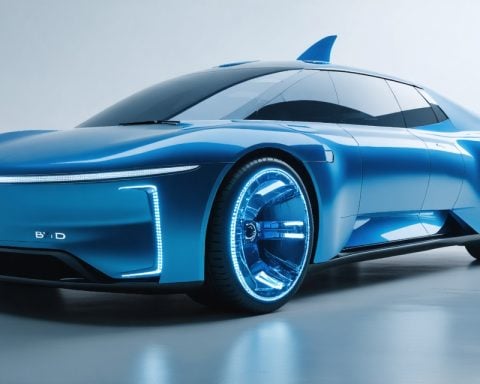- NVIDIA’s stock is 12% below its peak, following the rise of China’s DeepSeek, which developed an AI model using older NVIDIA GPUs for $5.6 million, causing market concern over GPU demand.
- Tech giants Amazon, Google, and Meta plan to invest a combined $235 billion by 2025, indicating strong demand for advanced GPUs.
- Google’s capital expenditure is projected to increase to $75 billion, reflecting a focus on AI application and inference, maintaining demand for NVIDIA’s hardware.
- Analysts predict NVIDIA’s revenue could grow to $196 billion by FY2026, with a significant 112% increase expected in FY2025.
- Despite DeepSeek’s impact, NVIDIA remains optimistic thanks to its advanced GB200 chip, which offers 30 times faster AI processing.
- Future tech investments from major companies suggest continued opportunities for NVIDIA’s growth and market leadership.
A shadow has been cast over NVIDIA as its stock trades 12% below its peak, echoing the whispers of an AI revolution stirred by China’s DeepSeek. This startup stunned the tech world, boasting an AI model trained on older NVIDIA GPUs for a mere $5.6 million, a move that raised eyebrows and triggered a January selloff. Concerns bubbled to the surface: Could this herald a waning demand for NVIDIA’s state-of-the-art GPUs?
But amidst the trepidation, tech giants offer a beacon of hope. Amazon, Google, and Meta plan to open their coffers wide, with combined capital expenditures brushing the $235 billion mark by 2025. Amazon leads this parade with $100 billion earmarked. For Google, a jump to $75 billion from last year’s $52 billion foreshadows a tech renaissance powered by sleek silicon and sprawling data centers.
Google’s CEO, Sundar Pichai, sheds light on a shifting tech landscape. The focus transitions from training AI to its application—inference—implying that NVIDIA’s hardware will remain a hot commodity. Meanwhile, Mark Zuckerberg of Meta notes a redirected hunger for chips to fuel inference rather than training.
Wall Street keeps faith. Analysts project NVIDIA’s revenue could soar to $196 billion by FY2026, a robust 52% growth. NVIDIA’s financial health reflects this optimism, forecasting an astounding 112% revenue jump for FY2025.
DeepSeek’s success, aided by crafty algorithms and deft AI distillation, only temporarily shook NVIDIA. As the sun sets on older GPU use, NVIDIA’s cutting-edge GB200, boasting 30 times faster AI processing, promises a renaissance for the chip leader.
So, while NVIDIA navigates turbulent waters, the looming tech expenditure from giants suggests a tidal wave of opportunity—lifting the GPU giant to new horizons.
Is NVIDIA Really at Risk? Here’s Why Their Future May Be Brighter Than You Think
How-To Steps & Life Hacks
For companies looking to optimize AI performance without breaking the bank, following DeepSeek’s strategy of using older NVIDIA GPUs might seem appealing. Here’s how you can achieve efficiency:
1. Assess Your AI Needs: Determine whether your AI applications are training-intensive or inference-focused. Older GPUs can be effective for the latter.
2. Optimize Algorithms: Use advanced algorithms that require less computational power, similar to DeepSeek’s approach. Frameworks like TensorFlow and PyTorch offer optimization tools.
3. Leverage Cloud Services: Services like Amazon Web Services (AWS) often provide access to a range of GPU models, allowing experimentation before committing to expensive hardware.
4. Monitor AI Workloads: Regularly profile and tune your models to ensure they are running efficiently, irrespective of the hardware used.
Real-World Use Cases
– Startups: Smaller entities can follow DeepSeek’s model by utilizing legacy GPUs, reducing initial capital expenditure.
– Academic Research: Institutions can leverage NVIDIA’s older models for research projects, saving budget for data acquisition and analysis.
– Continuous Deployment: Many enterprises use less powerful GPUs for deploying AI in production once models are trained, optimizing cost and efficiency.
Market Forecasts & Industry Trends
The AI hardware market continues to expand, with expectations for substantial growth. According to Gartner, the AI chip market is projected to grow by 40% annually till 2028. Despite the potential dip in demand for training-intensive hardware, the surge in inferencing requirements could support consistent growth for NVIDIA.
Reviews & Comparisons
– NVIDIA vs. AMD: NVIDIA generally leads in AI applications due to its CUDA platform and AI-focused development. However, AMD is making strides with its ROCm platform, offering a competitive edge, especially for cost-sensitive users.
– Current Generation GPUs: NVIDIA’s latest GB200 model significantly outperforms its predecessors and competitors in AI processing speed, making it ideal for cutting-edge AI tasks.
Controversies & Limitations
While DeepSeek’s move has stirred debate regarding hardware efficiency, it underscores the potential limitation of older systems in handling advanced AI models. Over time, relying on outdated tech could hinder competitive edge in rapidly evolving AI landscapes.
Features, Specs & Pricing
NVIDIA’s top-tier models like the A100 and the incoming GB200 offer cutting-edge AI capabilities, priced accordingly. As of 2023, A100 prices fluctuate based on demand but typically range from $10,000-$15,000, with enterprise licenses impacting cost.
Security & Sustainability
The development and deployment of AI involve significant energy usage. NVIDIA is investing in more energy-efficient chips, and users are encouraged to implement server optimization practices to reduce carbon footprints.
Insights & Predictions
Despite temporary challenges like the shock from DeepSeek, NVIDIA’s robust demand silhouette, bolstered by industry giants’ capital expenditure plans, suggests sustained growth.
Tutorials & Compatibility
For those looking to shift from training to inference:
– NVIDIA provides comprehensive tutorials and whitepapers on maximizing the performance of GPUs for inference tasks.
– Ensure software stacks (drivers, CUDA, and libraries) are up-to-date for optimal compatibility.
Pros & Cons Overview
Pros:
– Unmatched AI performance with newer models.
– Broad support through CUDA platform.
– Rapid expansion and revenue growth potential.
Cons:
– High initial costs for newer models.
– Competition from companies like AMD and cloud-based TPUs.
Conclusion & Recommendations
While utilizing legacy NVIDIA GPUs cuts costs initially, staying competitive requires incorporating newer models and embracing cloud solutions. Keep up with industry trends to maintain a technological edge.
For more on AI industry developments, visit NVIDIA.
—
Quick Tips
– Explore legacy GPU leasing opportunities for initial deployment.
– Always balance performance needs with budget constraints.
– Prioritize energy efficiency when upgrading infrastructure.













